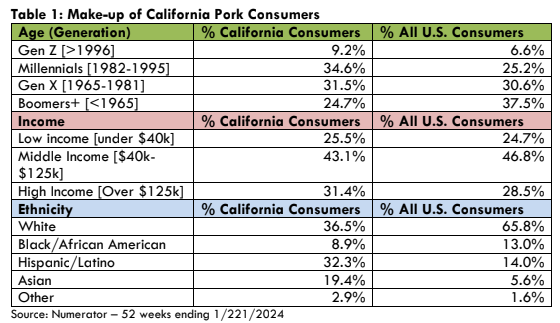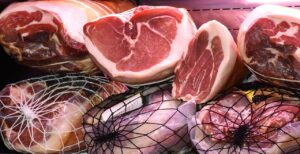On average, retail California pork prices have gone up by 20% since July 1, 2023, when Proposition 12 was fully implemented, says California economist Lon Hatamiya, president and CEO of the Hatamiya Group and former Secretary of the California Technology, Trade and Commerce Agency under Governor Gray Davis.
A new study released on May 9 shows pork prices are surging in California because of Prop 12, the state’s animal housing law that hit consumers at the beginning of 2024.
For example, bacon prices have gone up 16% between July 1, 2023 and Jan. 31, 2024. Meanwhile, pork rib prices have risen by 17%, pork loin prices have increased by a startling 41%, pork shoulder prices are 17% higher and fresh ham prices are 20% more now that Prop 12 is fully in effect, Hatamiya explains.
In actual dollar increases, the report said the average price of bacon increased from $6.46 per pound pre-July 1, 2023, to $7.74 per pound post-July 1, 2023. The average price of pork ribs increased from $3.12 per pound to $3.64 per pound, the average price of pork loin increased from $3.49 per pound to $5.12 per pound, the average price of pork shoulder increased from $2.04 per pound to $2.54 per pound, and the average price of fresh ham increased from $1.87 per pound to $2.29 per pound.
“These are the cuts that many of our communities across the state rely upon for their source of protein, not only in their home kitchens, but also in the ethnic restaurants that we have throughout the state,” he says.
California’s share of national pork consumption has declined, too. Hatamiya says it has fallen from about 10% of the national amount consumed to less than 8% as of Jan. 31.
“I would venture a guess that we took a further look at current numbers, it’s probably been declined further,” he adds. “California consumers most negatively impacted by these higher pork prices are younger, more diverse and certainly lower income folks. The people least able to be impacted by these higher prices are currently being negatively impacted.”
THE REAL VICTIMS OF PROP 12
This came as no surprise to Julian Canete, president and CEO of the California Hispanic Chambers of Commerce, who has been warning California about the fallout of Prop 12. He represents over 125 chambers and associations that represent the interests of California’s over 800,000 Hispanic-owned businesses.
“For the last several years, specifically, we’ve been concerned about how Proposition 12 was going to hurt the Hispanic community and communities of color, and now we’re seeing the impacts of a pork shortage and significant price increases,” Canete says. “We’re also finding an underground market where out-of-compliance work is being sold because consumers cannot afford a price increase on pork.”

Table 1 indicates 43.8% of all California pork consumers are millennials and GenZ. Also, the vast majority of California pork consumers (63.5%) are Black/African American, Hispanic/Latino, Asian, and other. Not only are California pork consumers younger and more ethnically diverse than all U.S. pork consumers, but there is also a larger percentage of low-income California pork consumers than the rest of the U.S. (25.5%). Therefore, the burden of higher retail pork prices in California falls mainly upon the younger, diverse, and lower income consumers across the state. Source: Hatamiya.
A protein staple for the Hispanic community, as well as other communities of color, pork is heavily consumed in a variety of ethnic dishes, snacks and other food products.
“This is why the Food Equity Alliance is calling on Congress to keep in mind Proposition 12’s startling impact on American families and businesses. We fear the same food affordability issues in California will come for the rest of the country without congressional action,” Canete says.
Prop 12 is a mess, points out Ruben Guerra of the Latin Business Association. He says it’s creating chaos and confusion throughout the food supply chain from producers and processors to grocers, restaurants and families.
“Food insecurity is an issue, and we must take it seriously. Over 3 million households in California were considered food insecure, including over 1 million families,” Guerra says. “Children’s food insecurity can lead to hunger, poor physical and mental health, and poor academic performance.”
The problem is this is not about what’s best for the consumer or for the pig.
“Those behind Prop 12 want to end meat consumption, not only in California, but throughout the nation,” Guerra adds. “They’re attempting to achieve this objective by making products such as pork unattainable for the average consumer. We know that Prop 12 is hurting Californians, and the Latino community is taking the hardest hit.”
NOW WHAT?
Pork has been one of the most affordable sources of protein, Hatamiya says. By raising the price of pork by 20%, families will now have 20% less to spend on other things if they continue to consume pork. Or, they will spend it on less pork or stop eating pork altogether.
And he doesn’t expect this trend to change as the cost of pork production for the California marketplace has risen, too.
“We like to eat our tacos, and our tacos have carnitas, or pork. They used to cost $1 or $1.50 and now they are like $3 or $4 — it’s ridiculous,” Guerra says. “It’s hurting our low-income people here in California and across the nation.”




